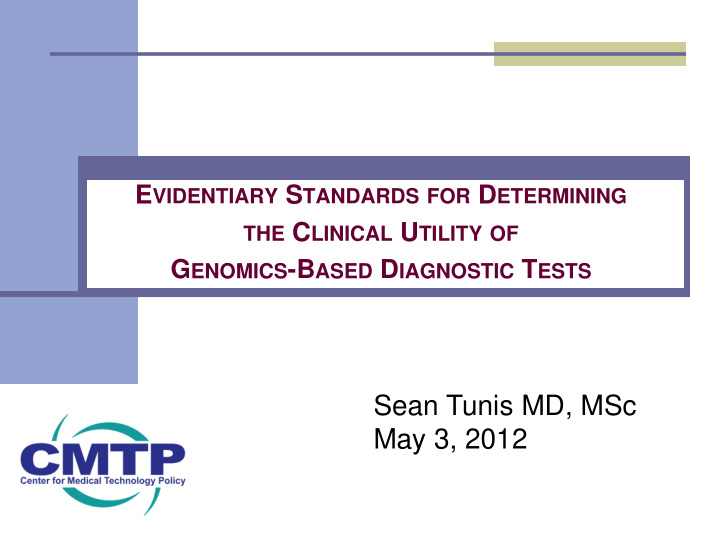



E VIDENTIARY S TANDARDS FOR D ETERMINING THE C LINICAL U TILITY OF G ENOMICS -B ASED D IAGNOSTIC T ESTS Sean Tunis MD, MSc May 3, 2012
EGAPP Working Group (Teutsch et al, Genet Med, 2008) • “Of most concern, the number and quality of studies are limited. Test applications are being proposed and marketed based on descriptive evidence and pathophysiologic reasoning, often lacking well-designed clinical trials or observational studies to establish validity and utility, but advocated by industry and patient interest groups” 2
The CER/PCOR Hypothesis • Gaps in evidence will be reduced through greater engagement of decision makers (patients, clinicians, payers) in: – Selecting and refining research questions – Developing study protocols 3
4
FDA Regulation of IVD • reasonable assurance that the probable benefits outweigh any probable risks – 21CFR860.7(d)(1) • reasonable assurance that the use of the device will provide clinically significant results – 21CFR860.7(e)(1) 5
Medicare guidelines for evaluation of dx tests (clinical utility) • Question 1: Is the evidence adequate to determine whether the test provides more accurate diagnostic information? • Question 2: If the test changes accuracy, is the evidence adequate to determine how the changed accuracy affects health outcomes?
BCBSA Criteria • The scientific evidence must permit conclusions concerning the effect of the technology on health outcomes. – The evidence should consist of well-designed and well- conducted investigations published in peer-reviewed journals. – The evidence should demonstrate that the technology can measure or alter the physiological changes related to a disease, injury, illness, or condition. In addition, there should be evidence or a convincing argument based on established medical facts that such measurement or alteration affects health outcomes. 7
x x x 2011 BIO / Health Advances 8
NHIC / CMS Policy on Oncotype Dx NEJM Paper State Association GHI meets with GO Adamant Coverage LCD CMS, Pt A, Pt B, FDA ALJs Unambiguous 2004 2005 2006 Noncoverage Draft LCD Tried to mimic NCA, TEC analysis New Tech, Lab Wkgps
SACGHS recommendation • “Information on clinical utility is critical for managing patients, developing professional guidelines, and making coverage decisions.” • “HHS should create a public private entity of stakeholders to….establish evidentiary standards and levels of certainty required for different situations” 10
Guidance for Comparative Effectiveness • Recommendations for study design reflecting information needs of patients, clinicians, payers – Analogous to FDA-guidance – Specific to a define class of interventions • Targeted to public/private sector clinical researchers • Describe study designs that provide “ reasonable confidence of improved health outcomes” • Balance validity with relevance, feasibility, timeliness • “Effectiveness Guidance Documents”
Example: PROs in off-label studies of oncology drugs • Include the following 14 patient-reported symptoms (“core symptom set”) in all research designs for post-market cancer clinical trials: anorexia, anxiety, constipation, depression, diarrhea, dyspnea, fatigue, insomnia, mucositis-oral, nausea, pain, sensory neuropathy, rash, and vomiting.
Technical Working Group on Clinical Utility of MDx in Oncology TWG Member Name Stakeholder Category Affiliation Linda Bradley Geneticist/Lab Director Women & Children's Hospital of Rhode Island Louis Jacques Payer Center for Medicare & Medicaid Services Gary Lyman Clinician Duke University Howard McLeod Researcher UNC Institute PGx & Individualized Therapy David Nelson Industry Epic Sciences David Parkinson Industry Nodality TBD FDA FDA Representative Margaret Piper Payer Blue Cross Blue Shield Tech Assessment Richard Simon Methodologist National Cancer Institute Mary Lou Smith Patients & Consumers Research Advocacy Network Plus 2-4 Additional Members
EGD Development Process • Review regulatory guidance and systematic reviews / clinical guidelines to identify gaps • Content experts generate initial draft recommendations • Technical working group refines draft recs • Mutely-disciplinary methods symposium to discuss key methods controversies • Revised recs circulated for public comment • Final methods recommendations posted 14
A better model for drug-licensing? Knowledge, investment Current model of licensing “The Magic Moment” (M. Lumpkin) Adaptive Licensing Time (years) 15
CED and Genomic Diagnostics • CED provides coverage contingent on participation in a clinical study (clinical trial, registry, etc) – For diagnostic tests, evidence of impact on health outcomes may not be feasible for initial coverage – However, unconditional coverage significantly reduces incentives to confirm health impacts – Optimal public health benefits from genomic diagnostics may be achieved through initial coverage at clinical validity, studies of clinical utility under CED 16
Contact Info • sean.tunis@cmtpnet.org • www.cmtpnet.org • 410 547 2687 x120 (W) • 410 963 8876 (M)
PCORI Methods Committee View JAMA. 2012;307(15):1636-1640 • “Engagement of patients at every step of the research process is viewed as essential, including in the selection of research questions, study design, conduct, analysis, and implementation of findings.” • “As such, the Methodology Committee is engaged in developing standards to support the validity and generalizability of research, as well as patient- centeredness.”
Recommend
More recommend